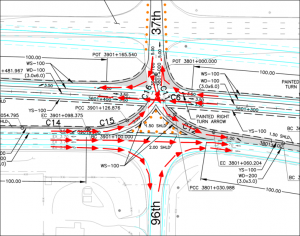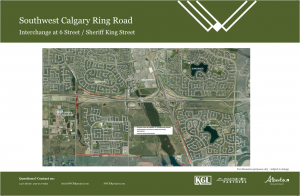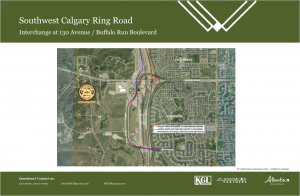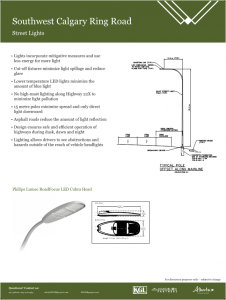Project Info
Noise
Dust
Roadways
Traffic Impacts
Light Pollution
West Calgary Ring Road
Noise
1. What are the project hours?
- The project hours for construction of the Southwest Calgary Ring Road (SWCRR) are Monday to Saturday from 7:00 a.m. to 10:00 p.m. and Sundays and holidays from 9:00 a.m. to 10:00 p.m.
- Select activities may occur outside of these hours with special permission from Alberta Transportation
- There are other third-party contractors carrying out construction in the Transportation Utility Corridor (TUC) that may work different hours
2. What are the construction noise restrictions?
- Construction activities are subject to a noise level restriction set by the Province of an average 65 decibels over a 24-hour period
3. Who do I contact if I have a noise concern?
- Inquiries can be directed to KGL Constructors
4. What are the road noise level restrictions for the SWCRR?
- The SWCRR is located within the Province’s TUC and is subject to provincial noise attenuation guidelines
- Alberta Transportation has adopted a noise level of 65 decibels over a 24-hour period (A-weighted) measured 1.2 metres above ground level and 2 metres inside the property line (outside the highway right-of-way)
- Additional resource:
5. Are the Province’s noise level restrictions the same as the City of Calgary’s?
- No, the provincial guidelines for noise attenuation in urban areas are different than those used by the City of Calgary; however, they are consistent with the policies used by the City of Edmonton and other urban areas
- The provincial guidelines have been used to determine the need for noise mitigation measures along the ring roads in Edmonton and Calgary
- The guidelines are regularly reviewed to ensure they remain applicable
6. Will there be noise mitigation along the SWCRR (e.g., a berm or wall)?
- The construction of noise mitigation measures is determined by the Province’s guidelines, which require that road noise be addressed if it reaches higher than a 65-decibel average over a 24-hour period.
- KGL undertook a noise modelling study to determine where noise mitigation measures may be required along the project corridor.
- During the operating period Mountain View Partners will implement additional noise mitigation measures should the thresholds be exceeded.
Dust
1. How is dust controlled?
- Dust at all work sites will be monitored regularly during SWCRR construction
- Mitigation measures include watering, application of dust palliatives, use of seeding tackifiers, and other site-specific measures
2. Who do I contact if I have a dust concern?
- Inquiries can be directed to KGL Constructors
Roadways
1. How do I report outages or suggest changes to traffic signals in the project corridor?
- Inquiries can be directed to KGL Constructors
2. Why are the speed limits so low along the project corridor?
- The speed limits in construction zones are set for the safety of workers and the travelling public:
- There may be workers or equipment in proximity to the road
- There may be construction activity, road conditions (e.g., excavations, material, or clear zones) or alignment changes that have changed or not apparent to the travelling public
- There may be equipment entering and exiting roads
3. How is KGL minimizing debris tracked onto public roads?
- Gravel strips or cattle guards are placed at access points to construction sites to remove mud from haul truck tires
- Haul trucks are swept before leaving sites to ensure they are clear of gravel
- KGL works with subcontractors to ensure that they adhere to all applicable regulations for hauling, including use of truck bed coverings
- A regular street sweeping program has been initiated on roads within the TUC
- KGL has retained the services of a 24/7 maintenance company that patrols the roads and performs spot cleanings as needed
4. How can I report debris on the road?
- Inquiries can be directed to KGL Constructors
5. How do you determine the location of haul roads along the project corridor?
- Haul routes are determined by project needs, access throughout the construction site and safety considerations to remove truck traffic and equipment from public roads
- In some cases, traffic signals may be installed along major roads in order to allow vehicles to safely enter and exit site access points
- Truck and equipment operators are provided with route maps to avoid residential neighbourhoods and congested areas
Traffic Impacts
1. Where can I find a list of traffic impacts for the upcoming construction season?
- A list of planned activities for the upcoming season is available on the Alignment Maps page
- A list of current and upcoming traffic impacts is available on the Traffic Updates page
2. Will access on 37 Street to and from Glenmore Trail be closed during construction?
- No, access on 37 Street to and from Glenmore Trail will remain open during the construction period
- A series of ramp realignments are planned for this area in order to maintain connectivity
3. Will the construction of the 37 Street interchange change traffic patterns in Lakeview?
- KGL is building the 37 Street interchange according to the contracted design provided by Alberta Transportation
- This, in turn, is based on the agreement between the province and the Tsuut’ina Nation
- If residents have concerns about future traffic impacts, they are encouraged to contact the City of Calgary to discuss potential traffic calming methods
4. When will you close 37 Street at Highway 22X?
- 37 Street changed to restricted movements in the fall of 2019
- This was due to the realignment of westbound traffic into the median of Highway 22X, which removed safe traffic queuing distances from the median
- Around the same time, KGL started rebuilding the old westbound lanes, which further restricted access
- Drivers on 96 Street W that want to head westbound should first drive on eastbound Highway 22X and then south on Tournament Lane to a cul-de-sac where they can turn around (150 metres south of 22X). They can then head north on Tournament Lane and safety make the left turn onto westbound Highway 22X.
- The full closure of 37 Street at Highway 22X is planned for 2020, once the frontage access road is available
5. Why does the new interchange at 6 Street / Sheriff King Street only provide limited access to Highway 22X?
- Sheriff King Street is in proximity to the other major interchanges of Macleod Trail and James McKevitt Road, which are intended for high speed, high traffic operations
- If Sheriff King Street did have additional access, it would result in traffic merging and exiting in very close proximity (compromising weave distances)
- This could result in a safety hazard or traffic bottleneck, similar to what sometimes occurs on Calgary’s existing roads
- 194 Avenue is being constructed by the City of Calgary to provide alternative access from Silverado to Spruce Meadows Way and to Macleod Trail
6. Why does the new interchange at 130 Avenue only provide limited access to the SWCRR?
- 130 Avenue is in proximity to the major interchange at Anderson Road, which is considered a systems interchange and intended for high speed, high traffic operations
- If 130 Avenue did have additional access, it would result in traffic merging and exiting in very close proximity (compromised weave distances)
- This could result in a safety hazard or traffic bottleneck, similar to what sometimes occurs on Calgary’s existing roads
- Drivers have additional access to the Anderson Road interchange via Buffalo Run Boulevard
7. When are you closing 45 Street at Glenmore Trail?
- The permanent closure of 45 Street access to and from Glenmore Trail is scheduled for November 3, 2019
8. Why are you closing 45 Street at Glenmore Trail?
- The closure of 45 Street is in preparation for a realignment of traffic on Glenmore Trail later in November
- This will shift Glenmore Trail to the south and away from 45 Street
- This will allow for the demolition of existing Glenmore Trail, installation of utility and drainage infrastructure, and construction of the new road
- There won’t be any access across this active work area
- The realignment will also shift traffic through a portion of the Sarcee Trail interchange
- This is a permanent closure of 45 Street
- The new free-flow interchange being built at Glenmore Trail and Sarcee Trail is intended for high speed, high traffic operations (no traffic signals or stops)
- Lower speed traffic entering from 45 Street would pose a significant safety concern, particularly as drivers on Glenmore Trail are changing lanes to access the various ramps of the interchange
Light Pollution
1. What is being done to limit light pollution from the SWCRR?
- There are a number of changes to lighting along the SWCRR, compared to other portions of the ring road
- Energy efficient LED luminaries are being used to reduce power consumption while maintaining required lighting levels (rather than high pressure sodium lights)
- Several different types of luminaries were reviewed and compared during the evaluation process
- The overall lighting approach for the SWCRR is to direct light downward on the roadway to avoid misdirection (light that radiates off to the sides and upward)
- Mitigation measures to reduce light trespass, pollution and glare include:
- Using energy efficient LED luminaries, which allow light to be placed accurately on the roadway
- Using luminaries that don’t emit any light directly to the sky
- Mounting luminaries on shorter light stands
- Reducing lighting to minimum levels, while maintaining the safe operation of the SWCRR
- Using retroreflective sign sheeting, so there aren’t any upward facing lights on directional signs



